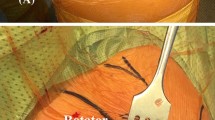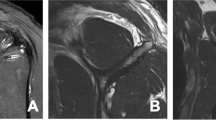Abstract
Purpose
A few studies have focused on factors predisposing to retear after arthroscopic revision rotator cuff repair (ARRCR). This study aimed to retrospectively evaluate (1) the structural and clinical outcomes of ARRCR and (2) pre- and intraoperative factors affecting the integrity of the rotator cuff (RC) tendon by focusing on preoperative RC tendon integrity, tear size, muscle hypotrophy and fatty infiltration.
Methods
Patients who underwent ARRCR between 2006 and 2016 were reviewed. Preoperative variables included demographic data, RC tendon integrity, tear size, and muscle hypotrophy and fatty infiltration on preoperative magnetic resonance imaging (MRI). Intraoperative variables included repair technique and completeness of repair. The visual analog scale for pain (PVAS), functional VAS (FVAS), American Shoulder and Elbow Surgeons scores, and shoulder range of motion (ROM) were assessed. Postoperative tendon integrity was evaluated using over 6-month follow-up MRI. Patients were classified into groups A (healed) and B (retear), and their variables were compared.
Results
Overall 65 patients with a mean follow-up of 49.5 ± 30.2 (range, 24.0–148.9) months were analyzed. Fifty-six of 65 (86.2%) patients underwent MRI at 9.1 ± 9.7 (range, 4.4–40.2) months after ARRCR, and 20 of 56 (35.7%) patients (group B) exhibited retear. Group A (36/56, 64.3%) showed higher functional scores and ROMs than group B at the final follow-up, with significant differences in the FVAS scores (Group A versus B: FVAS, 7.6 ± 1.8 versus 6.4 ± 1.9, p = 0.036). Intraoperative variables, including preoperative tendon integrity (p = 0.021), tear size (p = 0.007), supraspinatus and infraspinatus muscle hypotrophy and fatty infiltration (p < 0.001 and p = 0.046), and completeness of repair (p = 0.030), differed significantly between the groups. Multivariate analysis revealed that preoperative supraspinatus muscle hypotrophy and fatty infiltration were independent predisposing factors for retear after ARRCR [odds ratio = 7.5, 95% confidence interval (CI) 1.1–55.8, p = 0.048].
Conclusion
The retear was found in 20/56 patients (35.7%) after ARRCR for less than massive rotator cuff tears in this limited study population. Preoperative tendon integrity, tear size, supraspinatus and infraspinatus muscle hypotrophy and fatty infiltration, and completeness of repair was revealed to be associated with tendon integrity following ARRCR. Among them, preoperative supraspinatus muscle atrophy and fatty infiltration were the independent factors for retear after ARRCR, although generalization is limited.
Level of evidence
IV.

Similar content being viewed by others
References
Brochin RL, Zastrow R, Hussey-Andersen L, Parsons BO, Cagle PJ (2020) Revision rotator cuff repair: a systematic review. J Shoulder Elb Surg 29(3):624–633
Burkhart SS, Nottage WM, Ogilvie-Harris DJ, Kohn HS, Pachelli A (1994) Partial repair of irreparable rotator cuff tears. Arthroscopy 10(4):363–370
Choi S, Yang H, Kang H, Kim GM (2019) Treatment of large and massive rotator cuff tears: does infraspinatus muscle tear affect repair integrity? Clin Shoulder Elb 22(4):203–209
DeOrio JK, Cofield RH (1984) Results of a second attempt at surgical repair of a failed initial rotator-cuff repair. J Bone Jt Surg Am 66(4):563–567
Desai VS, Camp CL, Boddapati V, Dines JS, Brockmeier SF, Werner BC (2019) Increasing numbers of shoulder corticosteroid injections within a year preoperatively may be associated with a higher rate of subsequent revision rotator cuff surgery. Arthroscopy 35(1):45–50
Goutallier D, Postel JM, Bernageau J, Lavau L, Voisin MC (1994) Fatty muscle degeneration in cuff ruptures. Pre- and postoperative evaluation by CT scan. Clin Orthop Relat Res 304:78–83
Hagedorn P, Boehm D, Rolf O (2020) Midterm results after revision rotator cuff reconstruction: can ultrasound predict outcome of revision surgery? Musculoskelet Surg. https://doi.org/10.1007/s12306-020-00664-w
Harada N, Gotoh M, Ishitani E, Kakuma T, Yano Y, Tatara D, Kawakami J, Imai T, Karasuyama M, Kudoh Y, Shiba N (2021) Combination of risk factors affecting retear after arthroscopic rotator cuff repair: a decision tree analysis. J Shoulder Elb Surg 30(1):9–15
Hartzler RU, Sperling JW, Schleck CD, Cofield RH (2013) Clinical and radiographic factors influencing the results of revision rotator cuff repair. Int J Shoulder Surg 7(2):41–45
Hoffman TW, Maher A, Leigh WB, Brick MJ, Caughey MA, Young SW (2020) Medium-term outcomes of a cohort of revision rotator cuff repairs. J Shoulder Elb Surg 29(7):1346–1352
Iannotti JP, Deutsch A, Green A, Rudicel S, Christensen J, Marraffino S, Rodeo S (2013) Time to failure after rotator cuff repair: a prospective imaging study. J Bone Jt Surg Am 95(11):965–971
Jeong JY, Chung PK, Lee SM, Yoo JC (2017) Supraspinatus muscle occupation ratio predicts rotator cuff reparability. J Shoulder Elb Surg 26(6):960–966
Jeong JY, Pan HL, Song SY, Lee SM, Yoo JC (2018) Arthroscopic subscapularis repair using single-row mattress suture technique: clinical results and structural integrity. J Shoulder Elb Surg 27(4):711–719
Jeong JY, Yoon YC, Lee SM, Yoo JC (2018) Arthroscopic incomplete repair using a “Hybrid Technique” for large to massive rotator cuff tears: clinical results and structural integrity. Arthroscopy 34(7):2063–2073
Kim J, Ryu Y, Kim SH (2020) Surgical options for failed rotator cuff repair, except arthroplasty: review of current methods. Clin Shoulder Elb 23(1):48–58
Kim JY, Park JS, Rhee YG (2017) Can preoperative magnetic resonance imaging predict the reparability of massive rotator cuff tears? Am J Sports Med 45(7):1654–1663
Kluger R, Bock P, Mittlbock M, Krampla W, Engel A (2011) Long-term survivorship of rotator cuff repairs using ultrasound and magnetic resonance imaging analysis. Am J Sports Med 39(10):2071–2081
Kowalsky MS, Keener JD (2011) Revision arthroscopic rotator cuff repair: repair integrity and clinical outcome: surgical technique. J Bone Jt Surg Am 93(Suppl 1):62–74
Lee KW, Lee GS, Yang DS, Park SH, Chun YS, Choy WS (2020) Clinical outcome of arthroscopic partial repair of large to massive posterosuperior rotator cuff tears: medialization of the attachment site of the rotator cuff tendon. Clin Orthop Surg 12(3):353–363
Lim S, Kekatpure A, Chun JM, Kholinne E, Park JH, Jeon IH (2020) Clinical and imaging outcomes after revision open rotator cuff repair: a retrospective review of a midterm follow-up study. Indian J Orthop 54(5):639–646
Lo IK, Burkhart SS (2004) Arthroscopic revision of failed rotator cuff repairs: technique and results. Arthroscopy 20(3):250–267
Meshram P, Liu B, Kim SW, Heo K, Oh JH (2021) Revision rotator cuff repair versus primary repair for large to massive tears involving the posterosuperior cuff: comparison of clinical and radiological outcomes. Orthop J Sports Med 9(4):2325967121998791
Niglis L, Collin P, Dosch JC, Meyer N, Kempf JF, SoFcot (2017) Intra- and inter-observer agreement in MRI assessment of rotator cuff healing using the Sugaya classification 10 years after surgery. Orthop Traumatol Surg Res 103(6):835–839
Slabaugh MA, Friel NA, Karas V, Romeo AA, Verma NN, Cole BJ (2012) Interobserver and intraobserver reliability of the Goutallier classification using magnetic resonance imaging: proposal of a simplified classification system to increase reliability. Am J Sports Med 40(8):1728–1734
Sugaya H, Maeda K, Matsuki K, Moriishi J (2005) Functional and structural outcome after arthroscopic full-thickness rotator cuff repair: single-row versus dual-row fixation. Arthroscopy 21(11):1307–1316
Valencia Mora M, Morcillo Barrenechea D, Martin Rios MD, Foruria AM, Calvo E (2017) Clinical outcome and prognostic factors of revision arthroscopic rotator cuff tear repair. Knee Surg Sports Traumatol Arthrosc 25(7):2157–2163
Willinger L, Lacheta L, Beitzel K, Buchmann S, Woertler K, Imhoff AB, Scheiderer B (2018) Clinical outcomes, tendon integrity, and shoulder strength after revision rotator cuff reconstruction: a minimum 2 years; follow-up. Am J Sports Med 46(11):2700–2706
Zhao J, Luo M, Pan J, Liang G, Feng W, Zeng L, Yang W, Liu J (2021) Risk factors affecting rotator cuff retear after arthroscopic repair: a meta-analysis and systematic review. J Shoulder Elb Surg. https://doi.org/10.1016/j.jse.2021.05.010
Acknowledgements
We would like to thank Editage (www.editage.co.kr) for English language editing.
Funding
There is no funding in this study.
Author information
Authors and Affiliations
Corresponding author
Ethics declarations
Conflict of interest
There is no conflict of interest.
Ethical approval
IRB: Samsung Medical Center IRB no. 2018-01-153-003.
Additional information
Publisher's Note
Springer Nature remains neutral with regard to jurisdictional claims in published maps and institutional affiliations.
Rights and permissions
About this article
Cite this article
Kim, S.C., Shim, S.B., Kim, W.J. et al. Preoperative rotator cuff tendon integrity, tear size, and muscle atrophy and fatty infiltration are associated with structural outcomes of arthroscopic revision rotator cuff repair. Knee Surg Sports Traumatol Arthrosc 30, 2029–2038 (2022). https://doi.org/10.1007/s00167-021-06732-3
Received:
Accepted:
Published:
Issue Date:
DOI: https://doi.org/10.1007/s00167-021-06732-3




